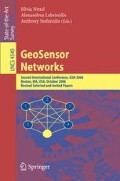Abstract
Traditional means of observing the ocean, like fixed moorings and radar systems, are expensive to deploy and provide coarse-grained data measurements of ocean currents and waves. In this paper, we explore the use of an inexpensive wireless mobile ocean sensor network as an alternative flexible infrastructure for fine-grained ocean monitoring. Surface drifters are designed specifically to move passively with the flow of water on the ocean surface and they are able to acquire sensor readings and GPS-generated positions at regular intervals. We view the fleet of drifters as a wireless ad-hoc sensor network with two types of nodes: i) a few powerful drifters with satellite connectivity, acting as mobile base-stations, and ii) a large number of low-power drifters with short-range acoustic or radio connectivity. We study connectivity and uniformity properties of the ad-hoc mobile sensor network. We investigate the effect of deployment strategy. The objective of this paper is to address the following challenge: how can we trade the usage of resources (e.g. number of drifters, and number of basestations vs. communication range) and which deployment strategy should be chosen (e.g. grid-like, star-like, etc.) to minimize energy costs, whilst satisfying application requirements for network connectivity and sensing density. Using simulation and real dataset, we investigate the effects of deploying drifters with regard to the following questions: i) where/when should drifters be placed initially? ii) how many drifters should initially be deployed?, iii) the effect of the number of basestations (drifters with satellite connectivity) on the overall network connectivity, and iv) the optimal communication range of the basic drifters. Our empirical study provides useful insights on how to design distributed routing and in-network processing algorithms tailored for ocean-monitoring sensor networks.
Access this chapter
Tax calculation will be finalised at checkout
Purchases are for personal use only
Preview
Unable to display preview. Download preview PDF.
References
Akyildiz, I.F., Pompili, D., Melodia, T.: Challenges for efficient communication in underwater acoustic sensor networks. ACM SIGBED Review 1(2), 3–8 (2004)
Akyildiz, I.F., Pompili, D., Melodia, T.: Underwater acoustic sensor networks: research challenges. Ad Hoc Networks 3(1), 257–279 (2005)
Ferentinos, K.P., Tsiligiridis, T.A.: Adaptive design optimization of wireless sensor networks using genetic algorithms. Elsevier Computer Networks 51(4), 1031–1051 (2007)
Gould, J., et al.: Argo profiling floats bring new era of in situ ocean observations. EOS 85(19), 179–184 (2004)
Nittel, S., Trigoni, N., Ferentinos, K., Neville, F., Nural, A., Pettigrew, N.: A drift-tolerant model for data management in ocean sensor networks. In: MobiDE, pp. 49–58. ACM Press, New York (2007)
U. of Washington. The neptune project page
Pettigrew, N., Churchill, J.H., Janzen, C., Mangum, L., Signell, R., Thomas, A., Townsend, D., Wallinga, J., Xue, H.: The kinematic and hydrographic structure of the gulf of maine coastal current. Deep Sea Research II 52, 2369–2391 (2005)
Proakis, J., Sozer, E., Rice, J., Stojanovic, M.: Shallow water acoustic networks. IEEE Communications Magazine 39(11), 114–119 (2001)
Sozer, E., Stojanovic, M., Proakis, J.: Underwater acoustic networks. IEEE Journal of Oceanic Engineering 25(1), 72–83 (2000)
Stojanovic, M.: Recent advances in high-speed underwater acoustic communication. IEEE Journal of Oceanographic Engineering 21, 125–136 (1996)
Vasilescu, I., Kotay, K., Rus, D., Dunbabin, M., Corke, P.: Data collection, storage, and retrieval with an underwater sensor network. In: SenSys 2005: Proceedings of the 3rd international conference on Embedded networked sensor systems, pp. 154–165. ACM Press, New York (2005)
Zhang, B., Sukhatme, G., Requicha, A.: Adaptive sampling for marine microorganism monitoring. In: IEEE/RSJ International Conference on Intelligent Robots and Systems (2004)
Author information
Authors and Affiliations
Editor information
Rights and permissions
Copyright information
© 2008 Springer-Verlag Berlin Heidelberg
About this chapter
Cite this chapter
Ferentinos, K.P., Trigoni, N., Nittel, S. (2008). Impact of Drifter Deployment on the Quality of Ocean Sensing. In: Nittel, S., Labrinidis, A., Stefanidis, A. (eds) GeoSensor Networks. GSN 2006. Lecture Notes in Computer Science, vol 4540. Springer, Berlin, Heidelberg. https://doi.org/10.1007/978-3-540-79996-2_2
Download citation
DOI: https://doi.org/10.1007/978-3-540-79996-2_2
Publisher Name: Springer, Berlin, Heidelberg
Print ISBN: 978-3-540-79995-5
Online ISBN: 978-3-540-79996-2
eBook Packages: Computer ScienceComputer Science (R0)

